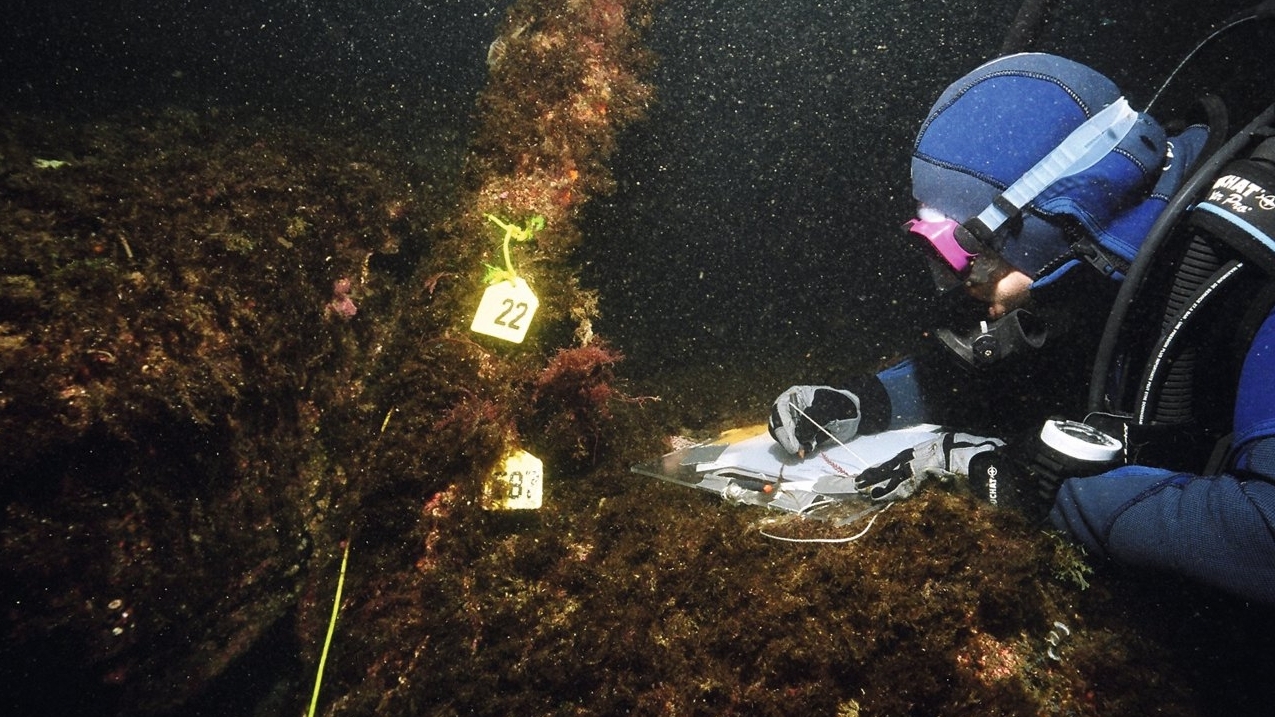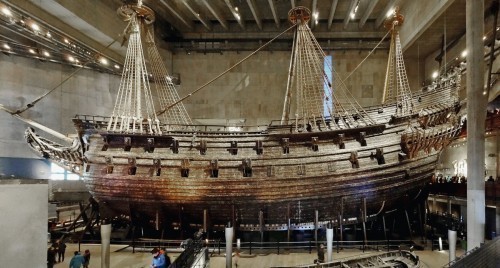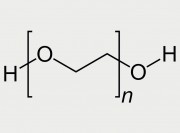A new process protects cultural objects made of wood from decay. Archaeologists speak of a turning point in conservation technology.
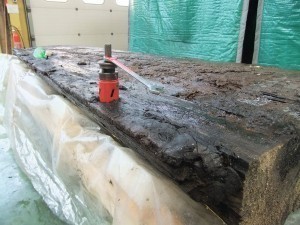 Taking samples to determine the acidity The year is 40 BC. In the morning mist of a hazy October day, a flat-bottomed Roman riverboat glides up the Rhône. The destination: Lugdunum. Ten years ago, the Julian Caesar had conquered free Gaul and was just about to become a big player in Rome. Three years ago, the Romans had founded Lugdunum, a strategically clever and scenic location at the confluence of the Rhodanus and Arar rivers *).
Taking samples to determine the acidity The year is 40 BC. In the morning mist of a hazy October day, a flat-bottomed Roman riverboat glides up the Rhône. The destination: Lugdunum. Ten years ago, the Julian Caesar had conquered free Gaul and was just about to become a big player in Rome. Three years ago, the Romans had founded Lugdunum, a strategically clever and scenic location at the confluence of the Rhodanus and Arar rivers *).
*) Lugdunum = Lyon, Rhodanus = Rhône, Arar = Saône, Mutina = Modena, Ilva = Elba
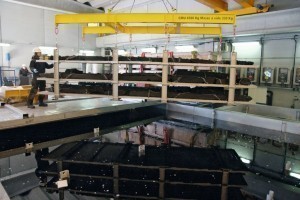 Ancient wooden artefacts are immersed in a tank of water, which is later inoculated with nanoparticlesTherowers are in good spirits. A light breeze has come up from the southwest and is billowing the sail. Although they are working against the current, the men hardly need to put any effort into the oars. And Lugdunum is an up-and-coming town. The food is excellent, there is plenty of wine and, by Jupiter, the girls are pretty, clean and cheap. So nothing can go wrong.Unfortunately, the crew has reckoned without the treacherous rapids and currents of the Rhodanus. They become reckless. In a careless moment, a powerful current seizes the barge and smashes it against a rock. The shallow, lightweight design now becomes her undoing. It leaks and the heavy cargo - marble blocks from Carrara, olive oil from Mutina and iron fittings from the island of Ilva*) - pulls the barge irrevocably into the depths. There it sinks into the sand. Some of the men manage to save themselves, the others drown.
Ancient wooden artefacts are immersed in a tank of water, which is later inoculated with nanoparticlesTherowers are in good spirits. A light breeze has come up from the southwest and is billowing the sail. Although they are working against the current, the men hardly need to put any effort into the oars. And Lugdunum is an up-and-coming town. The food is excellent, there is plenty of wine and, by Jupiter, the girls are pretty, clean and cheap. So nothing can go wrong.Unfortunately, the crew has reckoned without the treacherous rapids and currents of the Rhodanus. They become reckless. In a careless moment, a powerful current seizes the barge and smashes it against a rock. The shallow, lightweight design now becomes her undoing. It leaks and the heavy cargo - marble blocks from Carrara, olive oil from Mutina and iron fittings from the island of Ilva*) - pulls the barge irrevocably into the depths. There it sinks into the sand. Some of the men manage to save themselves, the others drown.
Fast forward to the 17th century after the turn of the century. The Thirty Years' War is raging in Central Europe. Swedish King Gustav II Adolf feels called upon to help Protestantism to victory. He wants to confront the Catholics on land and at sea. In 1625, the king gives the order to build the largest and most magnificent warship the world has ever seen. It was to block the mouth of the Vistula and make life difficult for the Catholic King Sigismund of Poland (who, in a twist of history, was Gustav II Adolf's brother).
A stability test went wrong
The new warship was to be called "Vasa", named after the glorious Swedish royal family. Lumberjacks set out and felled 1000 hand-picked oak trees in the province of Södermanslanden. The men had templates with them to identify the right trees. The actual work on the ship did not begin until 1626. A Dutch master shipbuilder named Hybertsson was in charge. He presented the king with a design for a flat-bottomed galleon with heavy cannons on the lower deck and light cannons on the upper deck. Gustav II Adolf accepted the proposal.
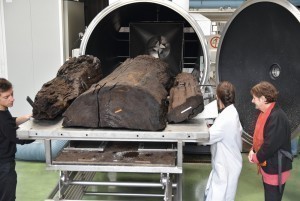 Drying processAfterthe construction work was already well advanced, the Swedish royal family received alarming news: the Danish king was in the process of building an even larger ship. This could not be left to stand. The king gave orders to enlarge the "Vasa". This could now only be done "upwards". The upper gun deck was therefore raised. The light cannons disappeared and were replaced by heavy ones. Hybertsson expressed his concerns, but was no longer able to push them through, as he died in 1627. The "Vasa" was therefore launched prematurely and subjected to a stability test: 30 sailors lined up on the port side and ran on the starboard side at the same time. The ship began to roll dangerously. The test was aborted, but construction continued according to the king's specifications and on August 10, 1628, the anchors were weighed for the maiden voyage. It was to be one of the shortest maiden voyages of all time. After sailing only 1,300 meters in calm weather and moderate winds, the "Vasa" capsized and sank in the waters of the Baltic Sea. More than 30 people lost their lives. A trial was later held, but no one was found guilty. Today we know that the ship was simply top-heavy. Efforts were immediately made to raise the prestigious ship again, but they all failed.
Drying processAfterthe construction work was already well advanced, the Swedish royal family received alarming news: the Danish king was in the process of building an even larger ship. This could not be left to stand. The king gave orders to enlarge the "Vasa". This could now only be done "upwards". The upper gun deck was therefore raised. The light cannons disappeared and were replaced by heavy ones. Hybertsson expressed his concerns, but was no longer able to push them through, as he died in 1627. The "Vasa" was therefore launched prematurely and subjected to a stability test: 30 sailors lined up on the port side and ran on the starboard side at the same time. The ship began to roll dangerously. The test was aborted, but construction continued according to the king's specifications and on August 10, 1628, the anchors were weighed for the maiden voyage. It was to be one of the shortest maiden voyages of all time. After sailing only 1,300 meters in calm weather and moderate winds, the "Vasa" capsized and sank in the waters of the Baltic Sea. More than 30 people lost their lives. A trial was later held, but no one was found guilty. Today we know that the ship was simply top-heavy. Efforts were immediately made to raise the prestigious ship again, but they all failed.
Gradually, the "Vasa" fell into oblivion. It was not until after the Second World War in the 1950s that the ship was remembered and a search began in 1951. It was finally found in 1956. Nevertheless, it took another 5 years before it was finally raised in 1961 - a masterpiece of shipbuilding and diving.
"Wooden artifacts, such as those found on old shipwrecks, are very important for archaeology," says Dr. Michel Sorent. He works at the University of Lyon and continues: "At the same time, however, they are extremely rare. In the vast majority of cases, wood rots in water after just a few years."
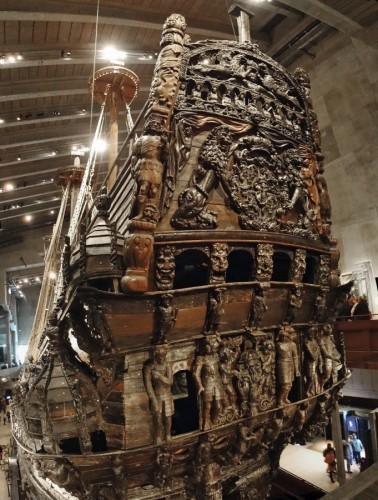 The stern shows the enormous dimensions of the "Vasa" in comparison to the visitorsSoall that remains of the Roman riverboat described at the beginning is the cargo, apart from a barely visible imprint in the sand. The wood of the hull, the hemp ropes and the linen sail had rotted away. Only the position of the cargo and its arrangement on the Rhône bed enabled the scientists to recognize that it had been transported by ship - and had not entered the river from the shore.
The stern shows the enormous dimensions of the "Vasa" in comparison to the visitorsSoall that remains of the Roman riverboat described at the beginning is the cargo, apart from a barely visible imprint in the sand. The wood of the hull, the hemp ropes and the linen sail had rotted away. Only the position of the cargo and its arrangement on the Rhône bed enabled the scientists to recognize that it had been transported by ship - and had not entered the river from the shore.
The discovery of the "Vasa", which had been stuck in the mud of the Baltic Sea for more than 300 years, was an absolute stroke of luck compared to the Roman barge.
But the wreck will remain an eternal construction site. Sorent: "From the moment a wooden artifact comes out of the water back into the air, the critical phase begins. Contact with oxygen triggers numerous decomposition processes."
The location of the Roman river boat, close to the shore in sand and silt, suggests that it has been lying there above the water level from time to time during the past 2000 years in summers with little rainfall. Intense UV radiation was added to this and these facts killed the wood.
However, due to its weight, the "Vasa" quickly sank into the Baltic Sea mud, which preserved the wood. The extremely low salt content of the Baltic Sea also prevented the shipworm, which literally devours wood, from taking hold.
Three influences endanger the wood
The two examples show the contrast: light, oxygen- and mineral-rich water accelerates decomposition processes, while dark, oxygen-poor water helps to preserve wood.
In fact, there are three main influences that endanger ancient wooden wrecks: mechanical forces, such as the force of the waves in the surf zone, break even iron parts into pieces in a short time. Biological factors are, for example, animals that feed on wood or settle on it and destroy it through metabolic products. Bacteria and fungi also have the same effect. Finally, it is chemical processes such as the formation of acids that destroy the structure of wood and cause it to rot.
Once again, the "Vasa" serves as an example - and test object - for science. After the wreck was raised in 1961, it was moved in ten short stages to a hall made of light metal. The old lady even had to cover some of the distances under her own steam, which she did brilliantly. As soon as the ship arrived at its final destination, it was sprayed with polyethylene glycol (PEG). The substance came from temporary hoses. The background to the treatment is as follows: the water originally contained in the wooden cells flows off and/or evaporates. The wood cracks and contracts. The water must therefore be replaced - preferably with a liquid that has preservative properties. PEG is ideal for this and also forms a protective film on the surface. Scientists thought they were on the safe side with the "Vasa". But more than 30 years after the ship was salvaged, those responsible at the museum were in for a nasty surprise. Today we know that the PEG treatment cannot prevent the formation of acids and that the wood can still contain corrosive chemicals even years later.
As we see the "Vasa" today, it has a matt to shiny brown surface finish, just like the oak furniture we know from home. During the inspection of the ship, however, microscopic mineral remains were discovered, which suggested that the "Vasa" could have been painted - and it was. However, research into the colors led to the sobering discovery that the wreck was practically in the process of destroying itself. The wood was around 40% softer than comparable oak wood. It was also extremely over-acidified. The reason for this is the sulphur in the wood, which gradually forms sulphuric acid, which in turn decomposes the wood. The Swedish press wrote in horror of the "second death of the 'Vasa'".
 The cross-section of the "Vasa" gives an idea of its top-heaviness
The cross-section of the "Vasa" gives an idea of its top-heaviness
"It's all half as bad," says Sorent. The colleagues took immediate action; many iron parts on the wreck were replaced with stainless steel parts, the air conditioning settings in the hall were optimized and, above all, the old lady is now regularly treated with neutralizing substances.
Harmless to humans and animals
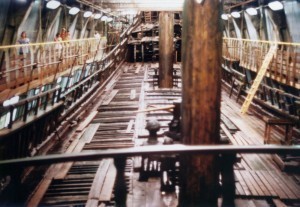 Conservation of the wreck in 1975 with polyethylene glycolDespiteall this, antiquities scientists were working on a new technology to reliably conserve ancient wooden artifacts such as wrecks. And modern nanotechnology offered the best possibilities. Nanoparticle products have been very important for cultural heritage research for some time now.
Conservation of the wreck in 1975 with polyethylene glycolDespiteall this, antiquities scientists were working on a new technology to reliably conserve ancient wooden artifacts such as wrecks. And modern nanotechnology offered the best possibilities. Nanoparticle products have been very important for cultural heritage research for some time now.
Traditional solutions are very expensive and potentially harmful to humans and the environment. Many contain alcohol as a solvent - a very volatile and flammable substance - and so they pose a huge risk and high cost when used over large areas (e.g. shipwrecks, which require huge tanks to be submerged during treatment).
A new innovative solution discovered by researchers at the University of L'Aquila, led by Prof. G. Taglieri, was able to produce and use nanoparticles directly in water - a cost-effective and safe process. This exciting, sustainable, scalable, environmentally friendly and cost-effective method can revolutionize traditional preservation methods.
In simple terms, all that happens is that calcium and magnesium hydroxide nanoparticles are placed directly into a tank filled with water containing the artifact to be preserved. This confirmed that the particles enter the wood unhindered and successfully deacidify it. Various methods were then used, including both preventive and conservative methods: These included atomic force microscopy, electron microscopy and X-ray probing. The structure of the nanoparticles was examined and the degradation of pollutants in the wood samples was detected.
Neutrons are an important tool in cultural heritage research as they are non-destructive and can penetrate deep into solid or liquid materials to visualize what is happening at the atomic or molecular level. This is an exciting field of application in which nanotechnology is helping humanity to understand and preserve its cultural heritage.
INFO
Polyethylene glycol, PEG for short, also known as polyethylene glycol and in pharmacy as macrogol, is a liquid or solid, water-soluble and non-toxic polymer with the general molecular formula C2nH4n+2On+1, depending on the chain length. Because of these properties, it is used in medicine, as an active ingredient carrier in pharmacy, in industrial applications, in cell biology research and in cosmetic products. PEG has different properties depending on the chain length and the resulting molar mass. The repeating unit of the linear polymer is (-CH2-CH2-O-), with a molar mass of around 44 g-mol-1. Chemically, it is a polyether.

